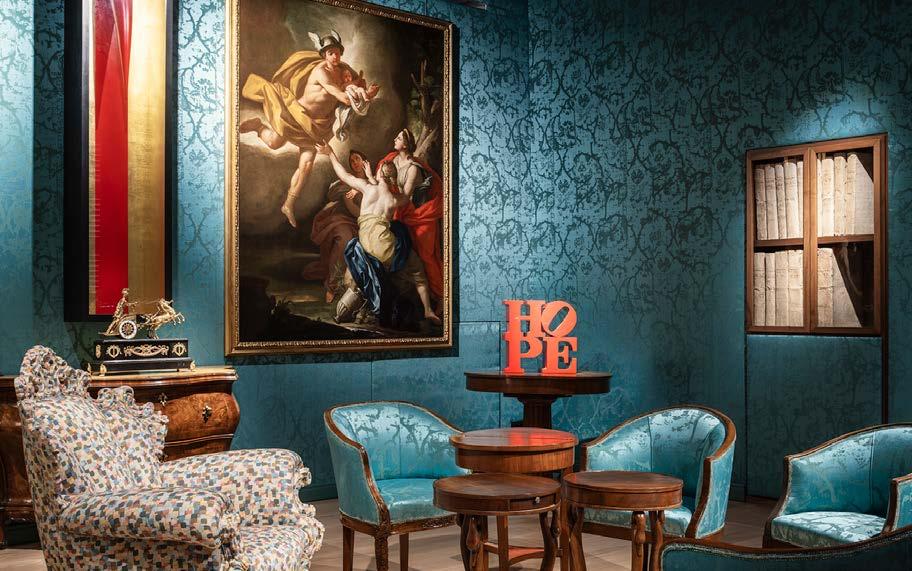
9 minute read
PALAZZO MAFFEI WHERE ART IS AT HOME
LANDMARKS & MUSEUMS ITINERARIES
An extraordinary collection in a unique location. Palazzo Maffei, which overlooks Piazza Erbe, is a house museum just waiting to be discovered.
Advertisement
>> Palazzo Maffei Casa Museo palazzomaffeiverona.com Piazza Erbe. T: 045 5118529. Open on Sat, Sun and festivities11am-6pm.
The Veronese entrepreneur and collector Luigi Carlon has recently opened his house-museum to the public: Palazzo Maffei, one of Verona’s most scenic 17th-century buildings, is a treasure trove of masterpieces and curiosities that has become a new reference point for art lovers. Five centuries of history for an exhibition of ancient and modern art, with more than 350 works, including almost 200 paintings, about twenty sculptures, drawings and an important selection of applied art objects. Twenty rooms decorated with stuccoes and frescoes overlooking Piazza Erbe make an elegant domestic setting into a wunderkammer that is a synthesis of the arts.
ITINERARIES
Giulietta between legend and reality
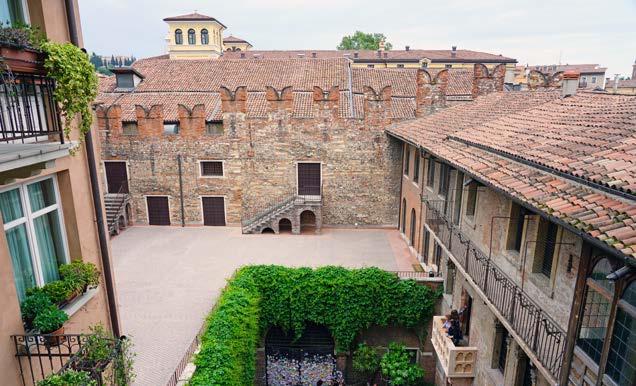
The universal fame of Romeo and Juliet stems from a 16th century novella set in Verona, inspired by Dante’s “Divine Comedy” and the story of the Montague and Capulet families. The story reached England at the end of the 16th century and was staged by William Shakespeare, whose immortal verses made the two unfortunate lovers universally famous. In the eighteenth century, European travellers on the Grand Tour went to visit Juliet’s tomb and would later attribute to her a home in this place where, from the balcony, according to tradition Juliet would look out to talk to her Romeo. Open to the public since 1973, after numerous restorations, Juliet’s House has become a house-museum and one of the most important tourist attractions in the city, giving it the reputation of the “city of love”. Don’t miss a souvenir photo next to the bronze statue of the heroine, better still if touching her right breast for good luck.
ITINERARIES
© MIKOLAJ NIEMCZEWSKI/SHUTTERSTOCK.COM
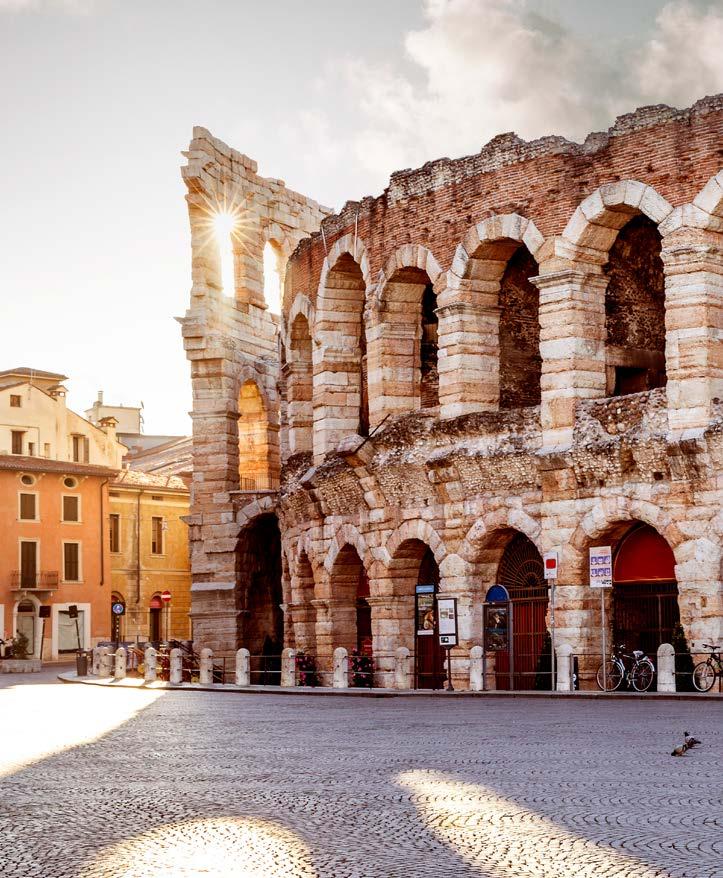
ARENA DI VERONA
Built around the 1st century A.D., this is a symbol of the city and the largest open-air opera house in the world. In an excellent state of preservation, what once was an ancient amphitheatre where gladiator shows took place is now used for operas and concerts. Every year since 1913 it has been hosting the famous Opera Festival. www.arena.it
ITINERARIES
© VLADIMIR SAZONOV/SHUTTERSTOCK.COM

CASA DI GIULIETTA
This is a tourist must-visit for all fans of Shakespeare’s tragedy “Romeo and Juliet”. The 13th-century Gothic tower-house is located in Via Cappello: in the courtyard there is the bronze statue of Juliet (which according to tradition grants luck and love to the person touching her breast) and the balcony described in Shakespeare’s romantic tragedy. casadigiulietta.comune.verona.it
ITINERARIES
© EFIRED/SHUTTERSTOCK.COM
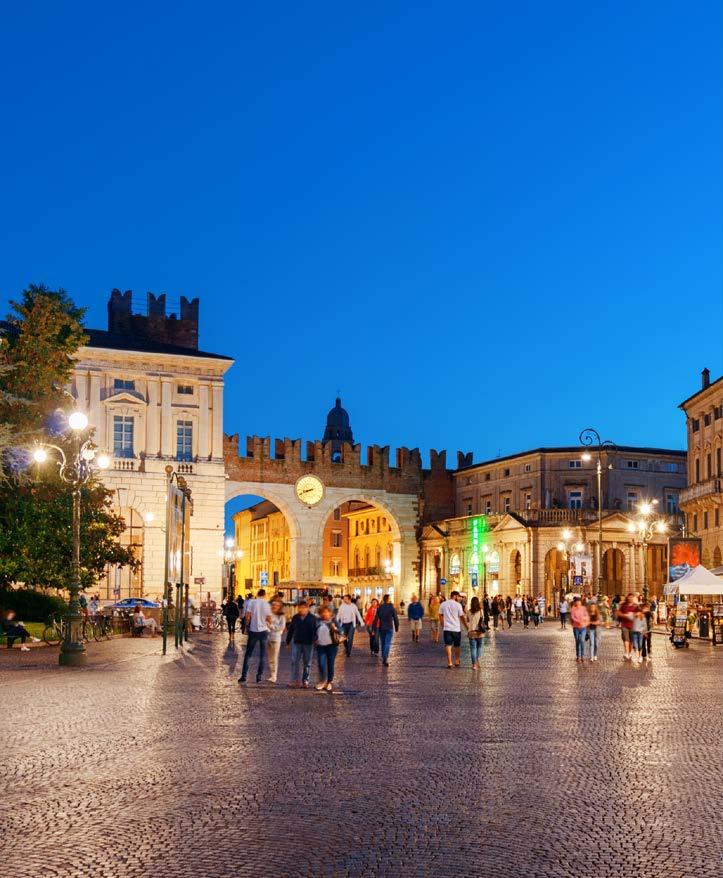
PIAZZA BRA
This is the largest square in Verona, overlooked by the famous Arena and a number of historic buildings, including Palazzo della Gran Guardia and Palazzo Barbieri. The characteristic “liston”, a sidewalk paved in pink marble from Valpolicella, with which the Arena was also built, is the perfect place to enjoy a coffee or an aperitivo, perhaps just before attending a show inside the amphitheatre.
ITINERARIES
© SAIKO3P/SHUTTERSTOCK.COM
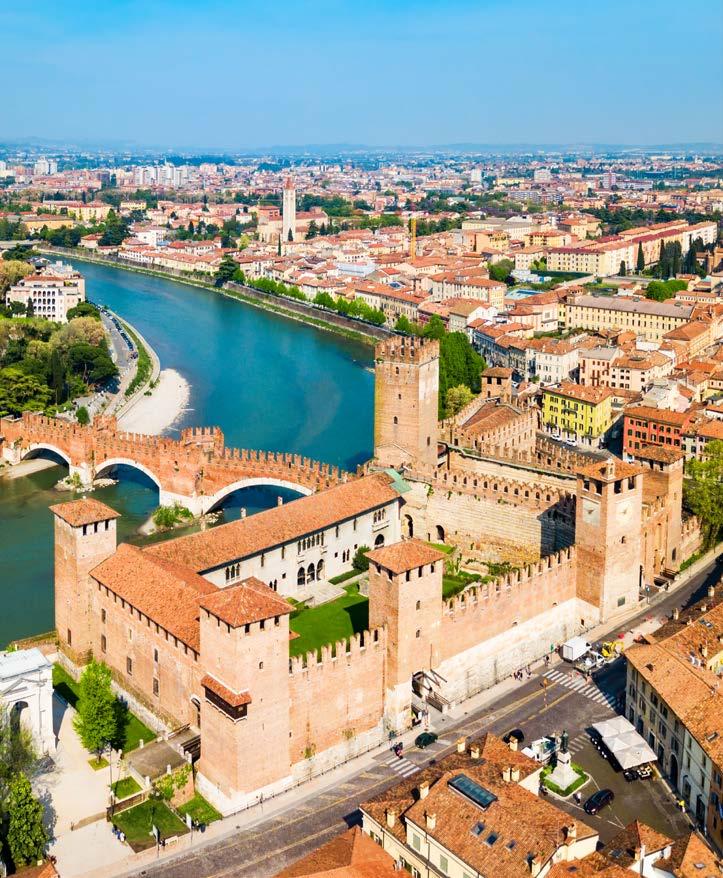
CASTELVECCHIO
This is one of Verona’s main monuments and today houses the city’s civic museum. Once the military seat of the Scaligeri family, it is now a place of historical interest that contains some of the most beautiful works of art in the city, as well as being an architecturally interesting building. museodicastelvecchio.comune.verona.it
ITINERARIES
© HIGH FLIERS/SHUTTERSTOCK.COM

TORRE DEI LAMBERTI
With its 84 metres overlooking Piazza delle Erbe, Torre dei Lamberti (built in 1172) is one of the tallest buildings in Verona. The central section of the tower is decorated with a large clock, while at the top are four bells. The top, which can be reached by lift or a spiral staircase, offers a spectacular view of the historic centre. www.torredeilamberti.it
ITINERARIES
© RENATA SEDMAKOVA/SHUTTERSTOCK.COM
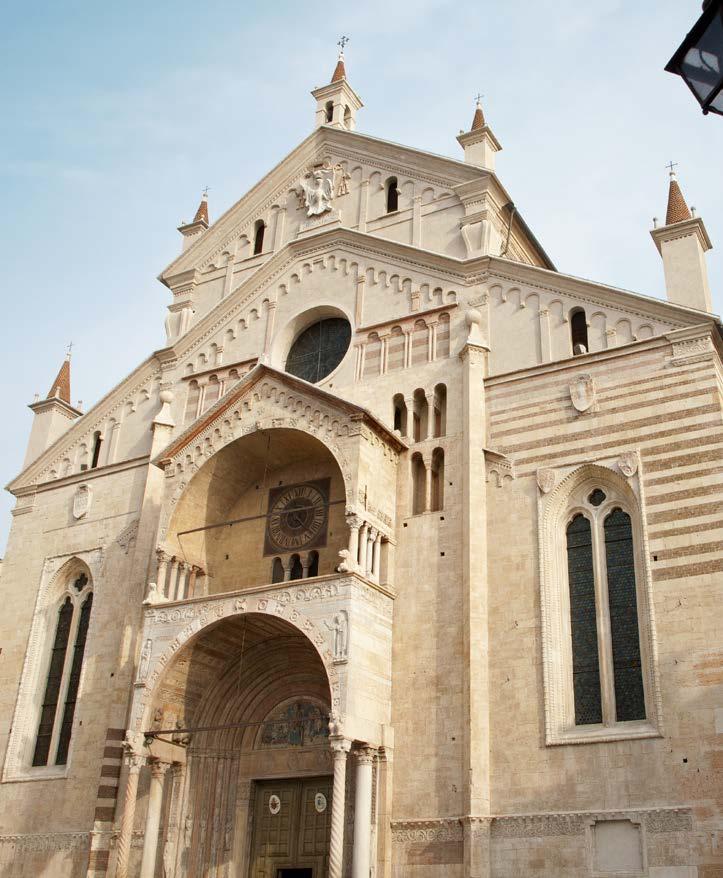
DUOMO DI VERONA
The church of early Christian origins was consecrated in 1187 by Pope Urban II and is part of an architectural complex that includes other religious buildings. The majestic and solemn interior of Romanesque design with Gothic touches on the façade contains Renaissance trompe l’œil frescoes and the famous painting “Assumption of the Virgin” by Titian (1535). www.cattedralediverona.it
ITINERARIES
© STEVE HEAP/SHUTTERSTOCK.COM

BASILICA DI SAN ZENO
The church dedicated to Verona’s patron saint has early Christian origins, it is a sacred place par excellence in the city and one of the masterpieces of Romanesque art in Italy. In the shape of a Latin cross with three naves, the interior is on three levels. Notable features on the façade are the central rose window, also known as the “Wheel of Fortune”, and the bronze portal. basilicasanzeno.it
ITINERARIES
© KAVALENKAU/SHUTTERSTOCK.COM
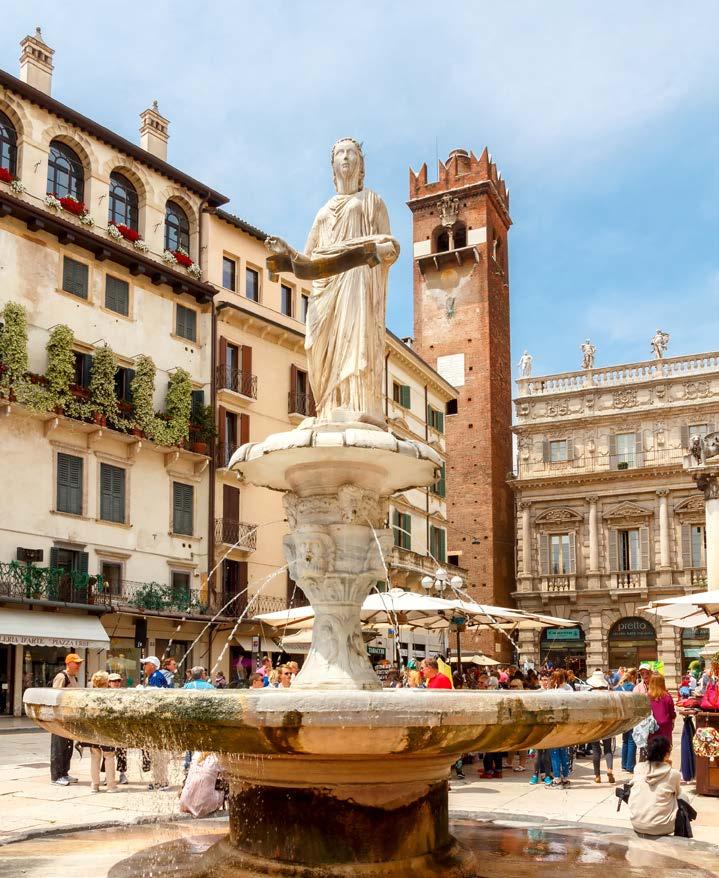
PIAZZA DELLE ERBE
Verona’s oldest square stands in the area of the Roman Forum, which for many centuries was the hub of the city’s social, economical and political life. Surrounded by palaces, towers and statues, among which the Torre dei Lamberti, it is considered one of the most characteristic squares in Italy. Every weekend a colourful fruit and vegetable market is held here.
ITINERARIES
© ALIAKSANDR ANTANOVICH/SHUTTERSTOCK.COM

PONTE PIETRA
It is the oldest of the seven bridges crossing the Adige River in the city and now the preferred transit route for those wishing to reach the Roman Theatre. Destroyed by the Germans in World War II, it was rebuilt with the rubble of the original bridge and retains the characteristic shape of donkey’s back, typical of Roman bridges.
ITINERARIES
© ALIAKSANDR ANTANOVICH/SHUTTERSTOCK.COM

CASTEL SAN PIETRO
To admire the city from a different point of view, you can take a nice walk up to Castel San Pietro (a funicular is also available). From the top of this hill, you can admire an enchanting panorama of Verona and the Adige River.
ITINERARIES
© FOTOLIZA/SHUTTERSTOCK.COM

GIARDINO GIUSTI
Located in the historic centre of Verona, this garden created at the end of the 14th century is considered one of the most significant examples of Italian Renaissance gardens. An oasis of greenery just a few steps from the Arena. A combination of nature, art and history that recalls many elements of the Medici gardens, an aesthetic reference point for the elite of the Renaissance. giardinogiusti.com
ITINERARIES
© ARTEM EVDOKIMOV/SHUTTERSTOCK.COM

ARCHE SCALIGERE
The Gothic funerary complex in the heart of the historic centre houses the tombs of the most illustrious members of the Scala family, one of the richest and most powerful families in ancient Verona. Among them is the Ark of Cangrande, Lord of Verona from 1308 to 1311, also known as the friend and protector of the great poet Dante Alighieri.
ITINERARIES
© MC MEDIASTUDIO/SHUTTERSTOCK.COM

TEATRO ROMANO
The 1st century B.C. open-air theatre is among the oldest buildings in the city. Built on the natural slope of the San Pietro hill, it was completely covered by buildings and dwellings after the end of the Roman era. Brought back to the surface at the end of the 19th century, it has been hosting musical concerts and theatrical performances since 1948. museoarcheologico.comune.verona.it
ITINERARIES
© ROSSHELEN/SHUTTERSTOCK.COM
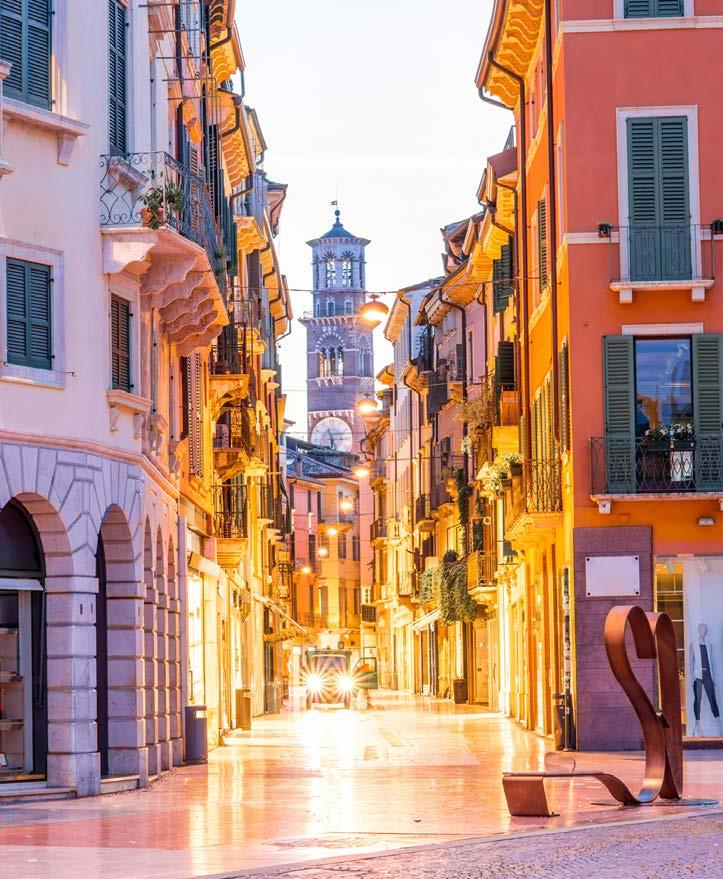
VIA MAZZINI
Via Mazzini is a narrow cobbled pedestrian street that connects the city’s two most important squares: Piazza Bra and Piazza delle Erbe. About 500 metres long, it is considered the shopping street, with rows of boutiques of the most famous fashion brands. Together with Corso di Porta Borsari, Corso Sant’Anastasia, Piazza delle Erbe and Via Cappello, it forms a small shopping district.
ITINERARIES
© ALTRENDO IMAGES/SHUTTERSTOCK.COM
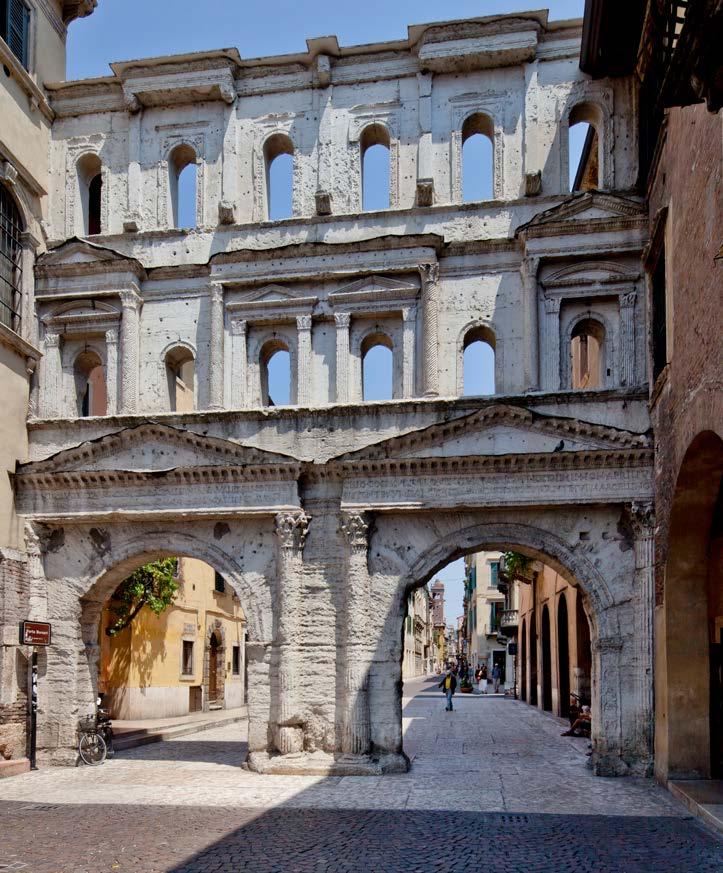
PORTA BORSARI
One of the gates that opened along the Roman walls of Verona, it dates back to the first century AD and was the main entrance to the city, being located along the axis of the decumanus (the main street in Roman times). In an excellent state of preservation, it is characterised by a white stone façade and an overall height of 13 metres, which also includes the upper defensive structure.
ITINERARIES
© ARTMEDIAFACTORY/SHUTTERSTOCK.COM
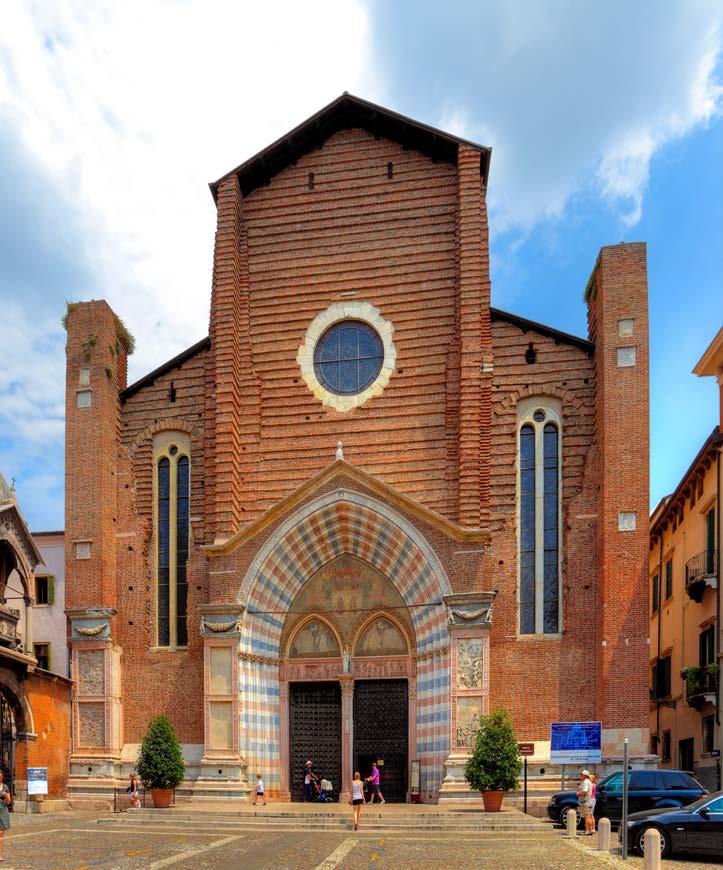
BASILICA DI SANTA ANASTASIA
The largest and most solemn Catholic church in Verona’s historic centre, this is also the city’s most important Gothic monument. Founded in 1290, its construction took over a century. The unfinished façade features a magnificent double portal with polychrome marble, reliefs and frescoes. Inside, the basilica has three large naves supported by 12 imposing columns of red Verona marble.
ITINERARIES
© ROUNDEX/SHUTTERSTOCK.COM
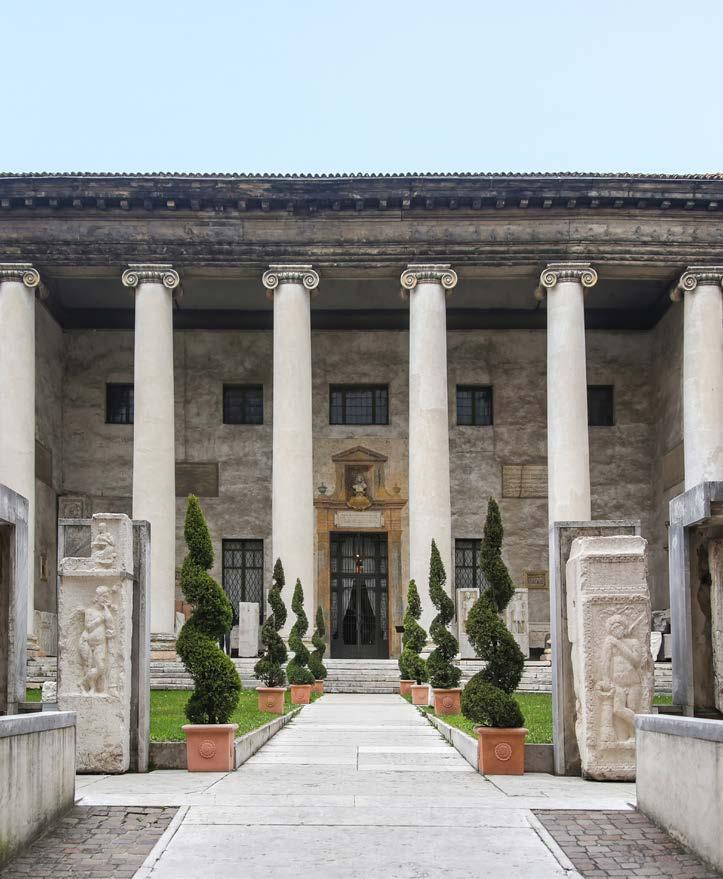
CASA MUSEO PALAZZO MAFFEI
In a spectacular seventeenth-century building overlooking Piazza delle Erbe, the extraordinary art exhibition born from the collecting passion of the Veronese entrepreneur Luigi Carlon is a “wunderkammer” with ancient masterpieces in dialogue with the modernity. The collection consists of over 350 works arranged in 20 rooms decorated with stuccoes and frescoes. palazzomaffeiverona.com
ITINERARIES
© FILIPPO CARLOT/SHUTTERSTOCK.COM

PIAZZA DEI SIGNORI
Also known as Piazza di Dante because of the statue dedicated to the Great Poet placed here in the 19th century, it is located near Piazza delle Erbe. Since the Middle Ages it has had administrative and political functions and from an architectural point of view it is characterised by the succession of historic buildings connected by arcades and loggias.
ITINERARIES
© CGE2010/SHUTTERSTOCK.COM

PONTE SCALIGERO
Also known as Ponte di Castelvecchio, it was built in the middle of the 14th century at the request of Cangrande II della Scala. It has been described as “the most daring and admirable work of the Middle Ages in Verona”, a masterpiece of military engineering: a robustness that has allowed it to cross five centuries of history and the harshest floods of the Adige River intact.
ITINERARIES
© ALIAKSANDR ANTANOVICH/SHUTTERSTOCK.COM

PALAZZO BARBIERI
Headquarters of Verona City Municipality, it is a neoclassical building constructed around the middle of the nineteenth century in Piazza Bra. Characterized by a majestic façade, for an Austrian military barracks, it recalls a Roman temple in its forms. The Sala degli Arazzi and the Sala del Consiglio Comunale are noteworthy for their paintings and furnishings.
ITINERARIES
© EQROY/SHUTTERSTOCK.COM

CASA DI ROMEO
A medieval building that belonged to the Montecchi family, now a private residence, it is characterised by an alternation of Romanesque, Gothic and Renaissance windows, surmounted by splendid battlements.
ITINERARIES
© ARTFOTOXYZ/SHUTTERSTOCK.COM
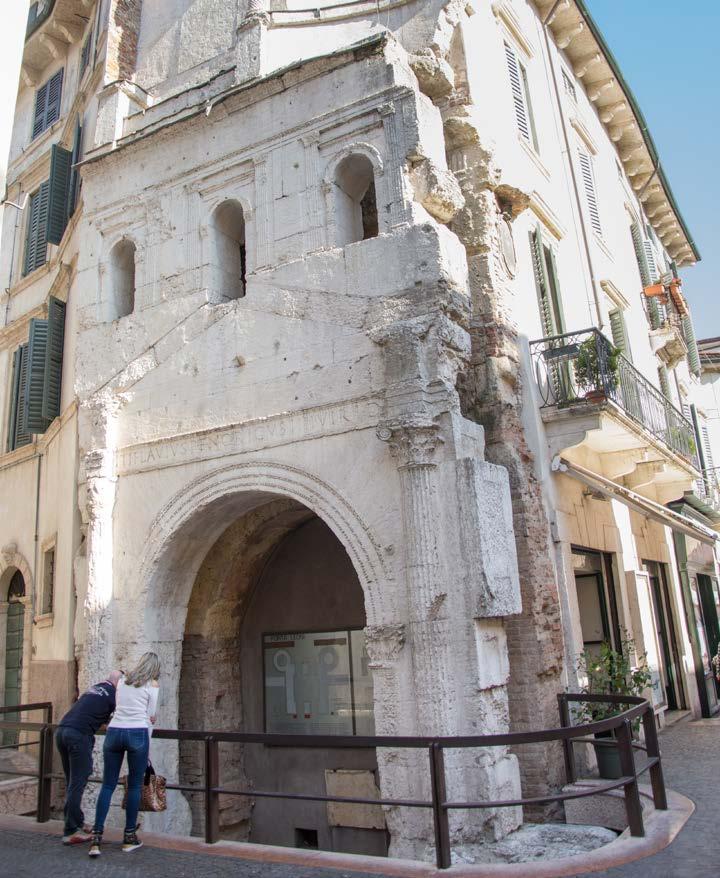
PORTA DEI LEONI
One of the gates that opened onto the city in Roman times (1st century BC), giving access to the cardo maximus, the city’s most important road axis after the decumanus. It takes its name from a sarcophagus found nearby depicting a pair of lions.










